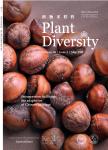Function of male and hermaphroditic flowers and size-dependent gender diphasy of Lloydia oxycarpa (Liliaceae) from Hengduan Mountains
Function of male and hermaphroditic flowers and size-dependent gender diphasy of Lloydia oxycarpa (Liliaceae) from Hengduan Mountains作者机构:School of Life Sciences Yunnan Normal University 650500 Kunming Yunnan China Key Laboratory for Plant Diversity and Biogeography of East Asia Kunming Institute of Botany Chinese Academy of Sciences 132 Lanhei Road 650201 Kunming Yunnan China
出 版 物:《Plant Diversity》 (植物多样性(英文版))
年 卷 期:2017年第39卷第4期
页 面:187-193页
核心收录:
学科分类:09[农学] 0903[农学-农业资源与环境]
基 金:supported by The National Key Research and Development Program of China (grant no. 2017YFC0505200) NSFC (grant 30360049 to Z.-M. L. and 31200183 to Y.N.),major Program of NSFC (grant 31590823 to H.S.)
主 题:Gender diphasy Lloydia Reproductive ecology Sexual system Size-dependent sex allocation
摘 要:Although hermaphroditism is common in flowering plants, unisexual flowers occur in many plant taxa,forming various sexual systems. However, the sexual system of some plants is difficult to determine morphologically, given that their sex expression may be influenced by both genetic and environmental factors. Specifically, androdioecy(the coexistence of both male and hermaphroditic individuals in the same population) has often been confused with the gender diphasy, a gender strategy in which plants change their sex expression between seasons. We studied the reproductive function of male and hermaphroditic flowers of Lloydia oxycarpa(Liliaceae), in order to investigate its sexual system and determine whether it is a gender-diphasic species. We found that although male flowers occur in a considerable number of plants, relative to hermaphrodites, they did not exhibit any significant reproductive advantage in terms of flower size, pollen quantity, attractiveness to visitors or siring success. In addition, this plant has spontaneous self-pollination and showed no inbreeding depression. These results render the maintenance of male individuals almost impossible. Furthermore, a considerable number of individuals changed their sex in successive years. The sex expression was found to be related to bulb size and dry weight, with larger individuals producing hermaphroditic flowers and smaller individuals producing male flowers. These results suggest that L. oxycarpa is not an androdioecious plant but represents a rare case of size-dependent gender diphasy.



